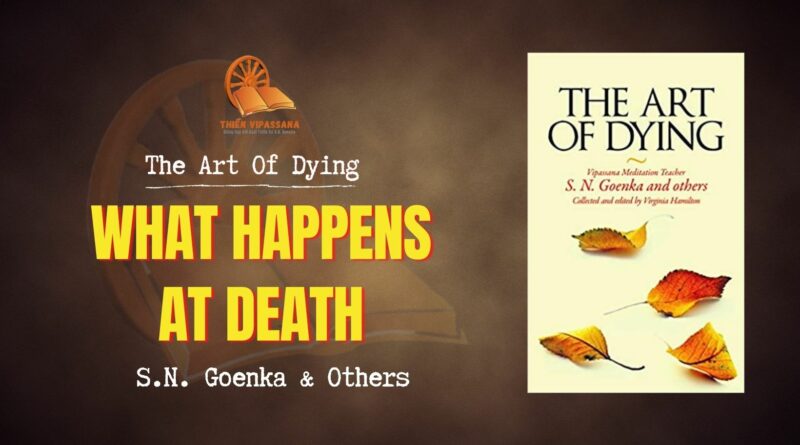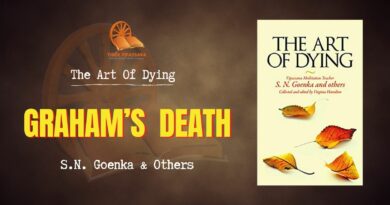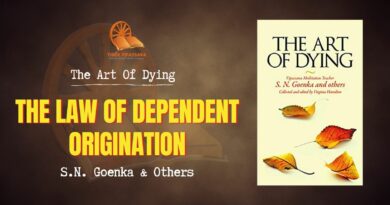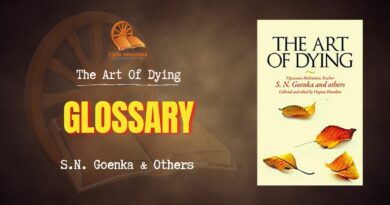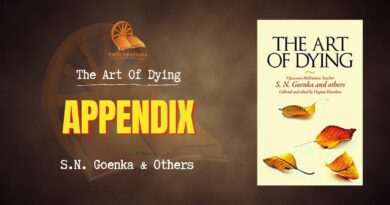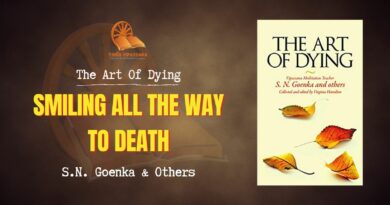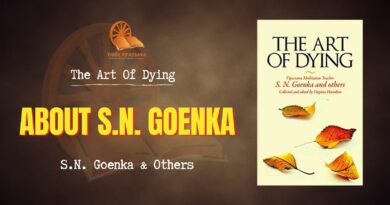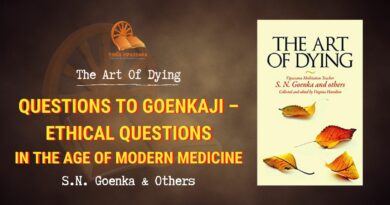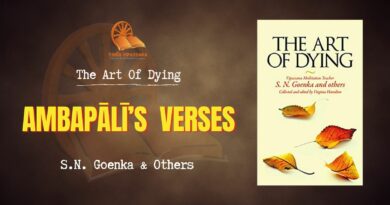What Happens at Death
This essay by Goenkaji originally appeared in the Sayagyi U Ba Khin Journal, Vipassana Research Institute, December 1991, and later in the Vipassana Newsletter, April 1992.
To understand what happens at death, let us first understand what death is. Death is like a bend in a continuous river of becoming. It might appear that death is the end of a process of becoming—and certainly it may be so in the case of an arahant (a fully liberated being) or a buddha—but for an ordinary person this flow of becoming continues even after death. Death puts an end to the activities of one life and the very next instant starts the play of a new life. On one side is the last moment of this life and on the other side is the first moment of the next life. It is as though the sun rises as soon as it sets, with no interval of darkness between. It is as if the moment of death is the close of one chapter in the book of becoming, and another chapter of life opens the very next moment.
Although no simile can exactly convey the process, one might say that this flow of becoming is like a train running on a track. It reaches the station of death and, after slightly decreasing speed for a moment, carries on again with the same speed as before. It does not stop at the station even for an instant. For one who is not an arahant, the station of death is not a terminus but a junction from where 31 different tracks diverge. The train, as soon as it arrives at the station, shifts onto one or another of these tracks and continues. This speeding train of becoming, running on the electricity of the kammic reactions of the past, keeps on traveling from one station to the next, on one track or the other—a continuous journey that goes on without ceasing.
This switching of tracks happens automatically. As the melting of ice into water and the cooling of water to form ice happen according to laws of nature, so also the transition from life to life is controlled by set laws of nature. According to these laws, the train not only changes tracks by itself, it also lays the next tracks for itself.
For this train of becoming, the junction of death where the change of tracks takes place is of great importance. Here the present life is abandoned; this is called in Pāli cuti (disappearance, death). The demise of the body takes place, and immediately the next life starts, a process called paṭisandhi (conception, or beginning of the next life). The moment of paṭisandhi is the result of the moment of death; the moment of death creates the moment of conception. Since every death moment creates the next birth moment, death is not only death but birth as well. At this junction, life changes into death and death into birth.
Thus, every life is a preparation for the next death. If one is wise, one will use this life to best advantage and prepare for a good death. The best death is the one that is the last, not a junction but a terminus: the death of an arahant. Here there will be no track on which the train can run further. But until such a terminus is reached, one can at least ensure that the next death gives rise to a good birth and that the terminus will be reached in due course. It all depends on us, on our own efforts. We are the makers of our own future; we create our own welfare or misery, as well as our own liberation.
How is it that we are the creators of the tracks that receive the onrushing train of becoming? To answer this question we must understand what kamma (action) is. Mental volition, whether skillful or unskillful, is kamma. Whatever wholesome or unwholesome volition arises in the mind becomes the root of all mental, vocal or physical action. Consciousness (viññāṇa) arises due to a contact at a sense door, then perception and recognition (saññā) evaluate the experience, sensations (vedanā) arise, and a kammic reaction (saṅkhāra) takes place.
These volitional reactions are of various kinds. Some are like a line drawn on water, disappearing immediately; some like a line drawn on sand, fading away after some interval; and others are like a line chiseled in rock, lasting for a very long time. If the volition is wholesome, the action will be wholesome and the fruits beneficial. But if the volition is unwholesome, the action will be unwholesome and will give fruits of misery.
Not all of these reactions result in a new birth. Some are so shallow that they do not give a significant result. Others are a bit deeper, but will be erased in this lifetime and not carry over into the next. Others, being still deeper, continue with the flow of this life and into the next birth, and can also multiply during this life and the next.
Many kammas, however, are bhāva-kammas or bhāva-saṅkhāras, those that give a new birth, a new life. Each one gives rise to the process of becoming and carries a magnetic force in tune with the vibrations of a particular plane of existence. The vibrations of that bhāva-kamma and the vibrations of that bhāva-loka (world, plane) attract each other and the two will unite according to universal laws pertaining to forces of kamma.
As soon as one of these bhāva-kammas is generated, this railway train of becoming gets attracted to one or other of the 31 tracks at the station of death. Actually, these tracks are the 31 planes of existence: the 11 kāma lokas (realms of sensuality—the four lower realms of existence, the human world, and six celestial realms), the 16 rūpa-brahma lokas (where fine material body remains), and the four arūpa-brahma lokas (non-material realms, where only mind exists).
At the last moment of this life a specific bhāva-saṅkhāra will arise. This saṅkhāra, capable of giving a new birth, will become connected with the vibrations of the related realm of existence. At the instant of death all 31 realms are open. The saṅkhāra that arises determines which track the train of existence runs on next. Like shunting a train onto a new track, the force of the bhāva-kamma reaction provides a push to the flow of consciousness into the next existence. For example, a bhāva-kamma of anger or malice, having heat and agitation as characteristics, will unite with some lower field of existence. Similarly, one like mettā (compassionate love), having peaceful and cool vibrations, can only unite with a brahma-loka. This is a law of nature, and these laws are so perfectly ordered that there is never any flaw in their operation. It must be understood, of course, that there is no passenger on the train except the force of accumulated saṅkhāras.
At the moment of death, generally, some intense saṅkhāra will arise. It may be of a wholesome or unwholesome nature. For example, if one has murdered one’s father or mother or perhaps some saintly person in this lifetime, then the memory of that event will arise at the moment of death. In the same way, if one has developed some deep meditation practice, a state of mind similar to that will arise.
When there is no such intense bhāva-kamma, then a comparatively less intense kamma will arise. Whatever memory is awakened will manifest as the kamma. One might remember the wholesome kamma of giving food to a saintly person, or the unwholesome kamma of hurting someone. Reflections on such past kammas as these can arise. Otherwise, objects related to that kamma might arise: the plate of food that was offered as dāna (donation) or the weapon used to harm. These are called the kamma-nimittas (signs, images).
Or perhaps a sign or a symbol of the next life might appear. This is called gati-nimitta (departing sign). These nimittas correspond to the bhāva-loka towards which the flow is attracted. It could be the scene of some celestial world, or perhaps of the animal world. The dying person will often experience one of these signs as a precursor, just as a train’s headlight illuminates the track ahead. The vibrations of these nimittas are identical to the vibrations of the plane of existence of the next birth.
A good Vipassana meditator has the capacity to avoid tracks leading to the lower realms of existence. He or she clearly understands the laws of nature and practices to be ready for death at all times. If one has reached an advanced age, there is all the more reason to remain aware every moment.
What preparations should one undertake? One practices Vipassana by remaining equanimous with whatever sensations arise in the body, thereby breaking the habit of reacting to them. Thus, the mind, which is usually generating new unwholesome saṅkhāras, develops the habit of being equanimous.
At the approach of death it is not unlikely that one will experience very unpleasant sensations. Old age, disease and death are dukkha (misery), and often, therefore, produce gross unpleasant sensations. If one is not skillful in observing these sensations with equanimity, one will likely react with feelings of fear, anger, sadness, or irritation, providing an opportunity for a bhāva-saṅkhāra of like vibration to arise. However, as in the cases of some well-developed meditators, one can work to avoid reacting to these immensely painful sensations by maintaining equanimity at the time of death. Then, even those related bhāva-saṅkhāras lying deep in the unconscious will not have an opportunity to arise.
A meditator at the point of death will be fortunate to have close relatives or friends nearby who can practice Vipassana and generate beneficial vibrations of mettā, which will create a peaceful Dhamma atmosphere, free from lamenting and gloom.
An ordinary person will usually remain apprehensive, even terror-stricken, at the approach of death, and thus allow a fearful bhāva-saṅkhāra to surface. In the same way, grief, sorrow, depression, and other feelings might arise at the thought of separation from loved ones, and the related saṅkhāra will come up and dominate the mind. A Vipassana meditator, by observing all sensations with equanimity, weakens these saṅkhāras so that they will not arise at the time of death. The real preparation for death is this: developing a habit pattern of repeatedly observing the sensations manifesting in the body and mind with equanimity and with the understanding of anicca.
At the time of death this strong habit of equanimity will automatically appear and the train of existence will switch to a track on which it will be possible to practice Vipassana in the new life. In this way one saves oneself from birth in a lower realm and reaches one of the higher ones. Because Vipassana cannot be practiced in the lower realms, this is very important.
At times a non-meditator will attain a favorable rebirth due to the manifestation at the time of death of wholesome bhāva-saṅkhāras such as generosity, morality, and other strong, wholesome qualities. But the special achievement of an established Vipassana meditator is to attain an existence where he or she can continue to practice Vipassana. In this way, by slowly decreasing the stock of accumulated bhāva-saṅkhāras, one shortens one’s journey of becoming and reaches the goal of liberation sooner.
One comes into contact with the Dhamma in this life because of the great merits one has performed in the past. Make this human life successful by practicing Vipassana, so that when death comes the mind is full of equanimity, ensuring well-being for the future.
—S.N. Goenka
Handadāni, bhikkhave, āmantayāmi vo, vayadhammā saṅkhārā, appamādena sampādetha.
Now, monks, I exhort you: All conditioned things have the nature of decay. Strive on diligently.
—Mahāparinibbāna Sutta, Dīgha Nikāya 2.185
Kāmayogena saṃyuttā,
bhāvayogena cūbhayaṃ;
Ditthiyogena saṃyuttā,
avijjāya purakkhatā.
Sattā gacchanti saṃsāraṃ,
jātimaraṇagāmino.
Bound by desire, tied to becoming, fettered tightly by false opinions, yoked to ignorance, whirled about: thus beings wander through saṃsāra, dying only to be born again.
—Aṅguttara Nikāya 4.10
Bài viết này được trích từ cuốn sách The Art of Dying – Thiền Sư S.N.Goenka và nhiều tác giả khác.

